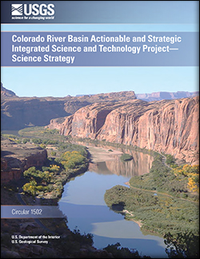Colorado River Basin Actionable and Strategic Integrated Science and Technology Project—Science Strategy
Links
- Document: Report (10.9 MB pdf) , HTML , XML
- Download citation as: RIS | Dublin Core
Abstract
The U.S. Geological Survey (USGS) conducts a wide variety of science that improves understanding of droughts and their effects on ecosystems and society. This work includes data collection and monitoring of aquatic and terrestrial systems; assessment and analysis of patterns, trends, drivers, and impacts of drought; development and application of predictive models; and delivery of information and decision-making tools to stakeholders. Stakeholders, which include Federal, Tribal, State, and local agencies, nongovernmental organizations, and others, use this information to anticipate, assess, react to, and mitigate drought conditions and impacts. There is no obvious near-term solution to reduce the frequency and severity of droughts or to mitigate drought impacts. Multidecadal drought is a “grand challenge” that benefits from integration of existing technologies, data, knowledge, and models across related and disparate disciplines, facilitated by new science and technology. In response, the USGS initiated a new integrated-science approach in the Colorado River Basin in 2020. The Colorado River Basin was specifically selected because of concerns about future drought and its consequences for the region. This document explains how the Colorado River Basin Actionable and Strategic Integrated Science and Technology (ASIST) project extends and enhances the science supported by USGS Mission Areas and Programs and articulates scientific gaps and stakeholder needs to identify and reduce drought risks. The approach seeks to answer complex Earth science questions developed in partnership with stakeholders about severe long-term drought. An integrated approach is required to tackle these complex questions, which any single science discipline cannot answer on its own.
In addition to increased understanding of drought and drought effects in complex systems, the Colorado River Basin ASIST project was designed to improve efficiencies through rapid location of a broad array of data sources, assembly of model-ready multidisciplinary data, and delivery of actionable science to stakeholders at the speeds and scales needed for decision making. The project team identified the following actions needed for USGS to implement and advance an integrated science approach in the Colorado River Basin: (1) engage with stakeholders to document their needs and iteratively co-produce science and science delivery tools to address these needs, (2) integrate monitoring and observation systems developed by USGS and other agencies that track droughts and their effects, (3) collect and provide analysis-ready data to support integrated applications, (4) integrate data and model connections to predict multiple drought impacts, (5) conduct multidisciplinary coordination to improve interpretations, (6) leverage the knowledge base across USGS to enhance decision making, and (7) support the development of new integrated science approaches and technologies that provide analysis and management tools that can be used to adapt to the effects of drought in the Colorado River Basin. Proposals for initial short-term use-case projects were solicited, a subset of which was selected for funding to test implementation of these actions. Additionally, the project organized and convened a series of science and technology collaboration workshops in the USGS focused on challenges that were identified and prioritized by the short-term use-case projects and during the initial stakeholder analysis. These workshops were designed to bring together diverse perspectives to discuss science and technology challenges, stakeholder needs, capabilities, and knowledge gaps, with the goal of determining how the USGS can address challenges, identify future opportunities for continued engagement between participants, and inform the next steps for the Colorado River Basin ASIST project. Continuing to collaboratively engage with a wide range of stakeholders using an integrated approach will provide a suitable foundation of data and tools to formulate actionable intelligence for predicting droughts and informing adaptation to the effects of long-term drought in a holistic, timely, and effective manner.
Suggested Citation
Dahm, K., Hawbaker, T., Frus, R., Monroe, A., Bradford, J., Andrews, W., Torregrosa, A., Anderson, E., Dean, D., and Qi, S., 2023, Colorado River Basin Actionable and Strategic Integrated Science and Technology Project—Science strategy: U.S. Geological Survey Circular 1502, 57 p., https://doi.org/10.3133/cir1502.
ISSN: 2330-5703 (online)
Study Area
Table of Contents
- Acknowledgments
- Abstract
- Introduction
- Colorado River Basin Stakeholders
- USGS Drought-Science Capacity—Opportunities for Enhancement
- Integrated Science Approaches to Understand and Reduce Long-Term Drought Risks
- Summary
- References Cited
- Appendix 1. Drought-Related Topics Relevant to Stakeholder Needs and Integrated Science Priorities
- Appendix 2. Colorado River Basin ASIST Project Use Cases
- Appendix 3. Science and Collaboration Workshops
| Publication type | Report |
|---|---|
| Publication Subtype | USGS Numbered Series |
| Title | Colorado River Basin Actionable and Strategic Integrated Science and Technology Project—Science strategy |
| Series title | Circular |
| Series number | 1502 |
| DOI | 10.3133/cir1502 |
| Publication Date | January 30, 2023 |
| Year Published | 2023 |
| Language | English |
| Publisher | U.S. Geological Survey |
| Publisher location | Reston VA |
| Contributing office(s) | Geosciences and Environmental Change Science Center |
| Description | vi, 53 p. |
| Country | Mexico, United States |
| State | Arizona, California, Colorado, Nevada, New Mexico, Sonora, Utah, Wyoming |
| Other Geospatial | Colorado River Basin |
| Online Only (Y/N) | Y |


